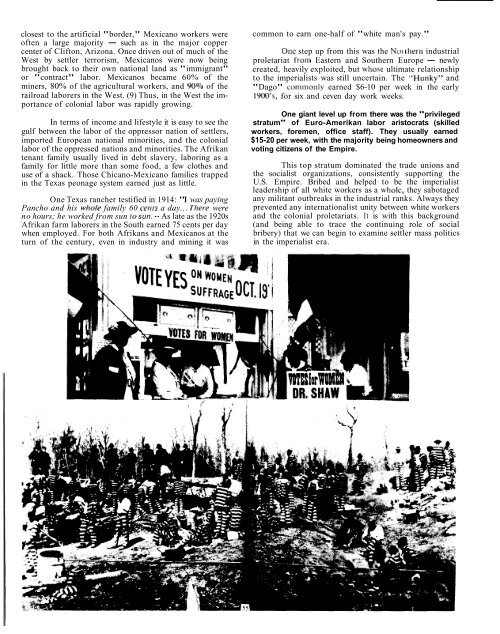Settlers - San Francisco Bay Area Independent Media Center
Settlers - San Francisco Bay Area Independent Media Center
Settlers - San Francisco Bay Area Independent Media Center
Create successful ePaper yourself
Turn your PDF publications into a flip-book with our unique Google optimized e-Paper software.
closest to the artificial "border," Mexicano workers were<br />
often a large majority - such as in the major copper<br />
center of Clifton, Arizona. Once driven out of much of the<br />
West by settler terrorism, Mexicanos were now being<br />
brought back to their own national land as "immigrant"<br />
or "contract" labor. Mexicanos became 60% of the<br />
miners, 80% of the agricultural workers, and 90010 of the<br />
railroad laborers in the West. (9) Thus, in the West the importance<br />
of colonial labor was rapidly growing.<br />
In terms of income and lifestyle it is easy to see the<br />
gulf between the labor of the oppressor nation of settlers,<br />
imported European national minorities, and the colonial<br />
labor of the oppressed nations and minorities. The Afrikan<br />
tenant family usually lived in debt slavery, laboring as a<br />
family for little more than some food, a few clothes and<br />
use of a shack. Those Chicano-Mexicano families trapped<br />
in the Texas peonage system earned just as little.<br />
One Texas rancher testified in 1914: "I was paying<br />
Pancho and his wl?ole family 60 cents a day.. . Tliere were<br />
no hours; he worked from sun to sun. " As late as the 1920s<br />
Afrikan farm laborers in the South earned 75 cents per day<br />
when employed. For both Afrikans and Mexicanos at the<br />
turn of the century, even in industry and mining it was<br />
common to earn one-half of "white man's pay."<br />
Onc step up from this was the Nut lhern industrial<br />
proletariat from Eastern and Southern Europe - newly<br />
created, heavily exploited, but whoce ultimate relationship<br />
to the imperialists was still uncertain. The "Hunky" and<br />
"Dago" con~~nonly earned $6-10 per week in the early<br />
19001s, for six and ceven day work weeks.<br />
One giant level up from there was the "privileged<br />
stratum" of Euro-Amerikan labor aristocrats (skilled<br />
workers, foremen, office staff). They usually earned<br />
$15-20 per week, with the majority being homeowners and<br />
voting citizens of the Empire.<br />
This top stratum dominated the trade unions and<br />
the socialist organizations, consistently supporting the<br />
U.S. Empire. Bribed and helped to be the imperialist<br />
leadership of all white workers as a whole, they sabotaged<br />
any militant outbreaks in the industrial ranks. Always they<br />
prevented any internationalist unity between white workers<br />
and the colonial proletariats. It is with this background<br />
(and being able to trace the continuing role of social<br />
bribery) that we can begin to examine settler mass politics<br />
in the imperialist era.

















